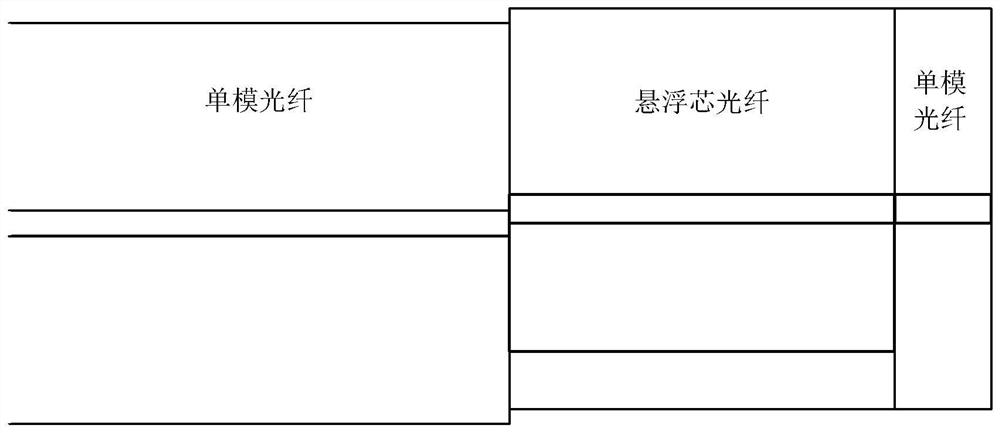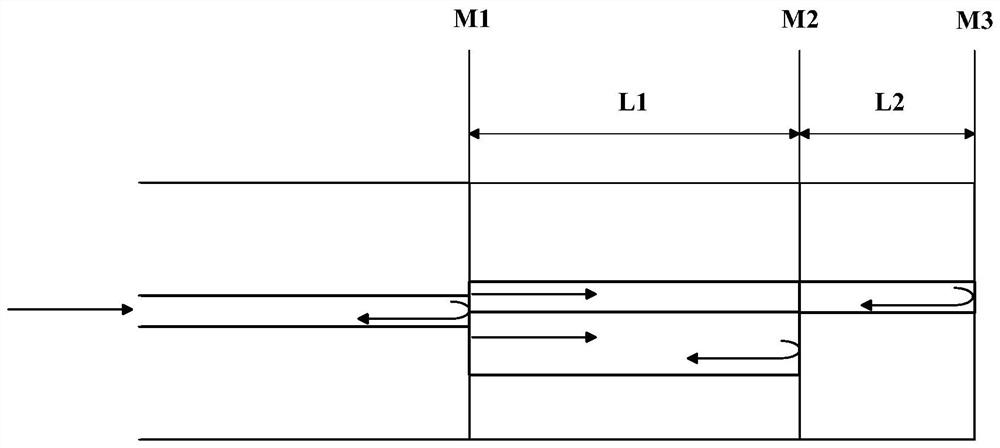Temperature sensor based on optical fiber double-cavity double vernier effect sensitization
A technology of temperature sensor and vernier effect, which is applied to thermometers, thermometers, instruments, etc. with physical/chemical changes, can solve the problems of long length of special optical fibers, insufficient integration, and no public reports, so as to avoid interference and improve Sensitivity, the effect of contributing to miniaturization
- Summary
- Abstract
- Description
- Claims
- Application Information
AI Technical Summary
Problems solved by technology
Method used
Image
Examples
specific Embodiment 1
[0026] A temperature sensor based on double-cavity optical fiber double vernier effect sensitization in this embodiment, the structural diagram is as follows figure 1 shown. The all-fiber dual-cavity cascade sensing device based on the double vernier effect includes a spontaneous emission amplification ASE light source as a wide light source (1), a fiber optic circulator (2), an introduction single-mode fiber (3), and a suspended core fiber (4) , tail-end single-mode optical fiber (5), spectrometer (6);
[0027] Spontaneous emission amplification ASE light source as a wide light source (1) emits continuous-wavelength laser light through a fiber circulator (2) and enters into a single-mode fiber (3) to be transmitted to a suspension core fiber (4) and a single-mode fiber at the end (5), The reflected light is transmitted to the spectrometer (6) to obtain an interference spectrum with a vernier effect.
specific Embodiment 2
[0029] A temperature sensor based on double-cavity optical fiber double vernier effect sensitization in this embodiment, on the basis of the specific embodiment 1, is further limited to include a suspended core optical fiber (4) with a length of 287 μm, its outer diameter is 125 μm, and the inner diameter is 125 μm. The fiber core is 9 μm, and there is an air hole with a diameter of 36 μm next to the fiber core. In order to ensure better performance of the sensor and facilitate the formation of a double vernier effect, the single-mode optical fiber (5) at the end is selected to have a length of 135 μm, an outer diameter of 125 μm, and an inner core of 9 μm. The structure of the sensor head is as figure 2 shown.
[0030] This structural design utilizes the close relationship between twice the free spectral range of the air cavity and twice the free spectral range of the quartz cavity to form a vernier effect. Enlarging the translation of the envelope to M times the translati...
specific Embodiment 3
[0032] A temperature sensor based on double-cavity double vernier effect sensitization of optical fiber in this embodiment, on the basis of specific embodiment 1, further defines that one end of the suspended core optical fiber (4) is connected to the end of the single-mode optical fiber (3) Welding, the corresponding welding surface is called the first welding surface; the other end of the suspension core fiber (4) is welded with one end of the tail end single-mode fiber (5), and the corresponding welding surface is called the second welding surface; Perform dislocation fusion splicing on the leading single-mode optical fiber (3) and the suspended core optical fiber (4). The core of the core fiber (4) is transmitted to the tail end single-mode fiber (5), and the other part is transmitted along the air hole of the suspended core fiber (4). Reflection occurs when the refractive indices of the two interfaces are different. Respectively at the interface between the imported sing...
PUM
| Property | Measurement | Unit |
|---|---|---|
| Length | aaaaa | aaaaa |
| Outer diameter | aaaaa | aaaaa |
| Diameter | aaaaa | aaaaa |
Abstract
Description
Claims
Application Information
 Login to View More
Login to View More - R&D
- Intellectual Property
- Life Sciences
- Materials
- Tech Scout
- Unparalleled Data Quality
- Higher Quality Content
- 60% Fewer Hallucinations
Browse by: Latest US Patents, China's latest patents, Technical Efficacy Thesaurus, Application Domain, Technology Topic, Popular Technical Reports.
© 2025 PatSnap. All rights reserved.Legal|Privacy policy|Modern Slavery Act Transparency Statement|Sitemap|About US| Contact US: help@patsnap.com



